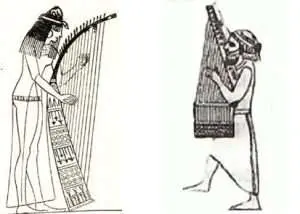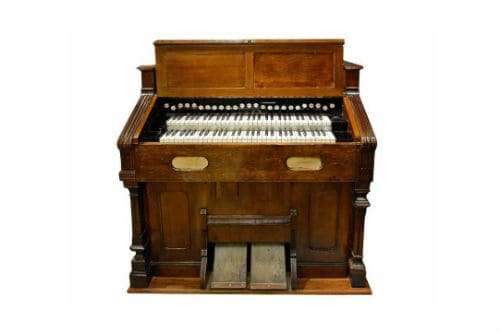
How to choose an acoustic guitar
Contents
Acoustic guitar is a stringed plucked musical instrument (in most varieties with six strings) from the guitar family. The design features of such guitars are: usually metal strings, a narrow neck and the presence of an anchor (metal rod) inside the neck to adjust the height of the strings.
In this article, the experts of the store “Student” will tell you how to choose exactly the acoustic guitar that you need, and not overpay at the same time. So that you can better express yourself and communicate with music.
Guitar construction
By understanding the basics of an acoustic guitar, you will be able to see and discern the nuances that will help you choose the most suitable instrument.
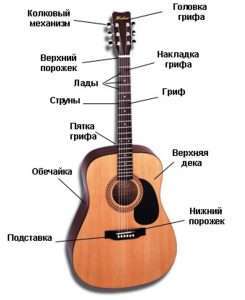
Acoustic guitar construction
1. Pegs (peg mechanism ) are special devices that regulate the tension of the strings on stringed instruments, and, first of all, are responsible for their tuning like nothing else. Pegs are a must-have device on any stringed instrument.

guitar pegs
2. Nut – a detail of stringed instruments (bowed and some plucked instruments) that raises the string above the fingerboard to the required height.
 Nut _ |  Nut _ |
3. Frets are parts located along the entire length of the guitar neck , which are protruding transverse metal strips that serve to change the sound and change the note. Also fret is the distance between these two parts.
4. Fretboard – an elongated wooden part, to which the strings are pressed during the game to change the note.
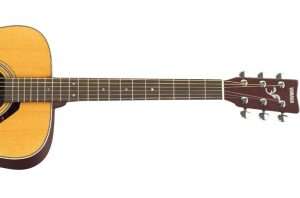
guitar neck
5. The heel of the neck is the place where the neck and body of the guitar are attached . Usually this concept is relevant for bolted guitars. The heel itself can be bevelled for better access to the frets . Different guitar manufacturers do it in their own way.
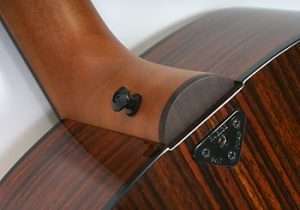
neck heel
6. Shell – (from Ch. to wrap around, wrap something around something) – the side of the body (bent or composite) muses. tools. It is easier to say that the shell is the side walls.

shell
7. Upper deck – the flat side of the body of a stringed musical instrument, which serves to amplify the sound.
Factors affecting sound
Despite the similar basic construction and design, acoustic guitars differ in important features that affect the sound, functionality, and feel of the instrument. These features include:
- type of shell
- housing material
- neck width and length
- strings – nylon or metal
- type of acoustic wood
Knowing the nuances in each of these categories will help you make the best choice when buying an acoustic guitar.
Enclosure Types: Comfort and Sonority
Before buying a guitar, it is important to make sure that, firstly, you are completely satisfied with the sound of this instrument, and secondly , it is convenient for you to hold it both sitting and standing.
The main body of the guitar is the soundboard . In general, the larger the deck , the richer and louder the sound. The combination of a large body and a narrow waist makes the guitar more comfortable. The exact dimensions of different models may vary depending on the manufacturer, but there are several common types of guitar bodies:
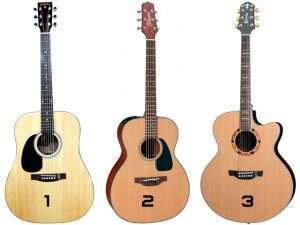
- Dreadnaught ( Dreadnought ) – standard western . Guitars with such a body are characterized by more pronounced bass with a peculiar “roaring” sound. Such a guitar is ideal for playing in an ensemble and playing chords in ami, but for solo parts it will not always be a good option.
- Orchestral Model . The “orchestra model” body type tends to have a smooth and “soft” sound – perfect balance between the lower and upper strings. These guitars are perfect for picking. The main disadvantage is only a weak volume of the instrument, if, for example, you play such a guitar in an acoustic ensemble. Still quite often there is not enough bass, especially with a hard playing style.
- Jumbo – ” jumbo ” (enlarged body). This type of acoustic guitar body is a kind of compromise between the previous two. Its main advantage is a large body that amplifies the sound to the level of a standard western (sometimes even more), and its symmetrical configuration makes it balanced and close to an orchestral model with a characteristic “juicy” tone. ” Jumbo ” guitars are well suited for mixed styles of music, especially when played on stage. The 12-string jumbo is also very popular .
The first two types of hull construction, which are still the most famous and common to this day, were developed by Martin. Westerns and orchestral models are the Martin D-28 and Martin OM-28. The design of the third type, or rather its development, belongs to the Gibson company, in which the Gibson J-200 model is still the traditional American ” jumbo ” guitar.
Guitar body material
The sound created by the guitar strings is transmitted through the tailpiece to the soundboard, which serves as an amplifier. The wood used to make the top has a primary influence on the character of the instrument’s sound. That is why, as mentioned above, the larger the deck , the louder the sound.
The top deck of an acoustic guitar can be solid or laminated. A solid soundboard is usually made from two single-ply pieces of wood with a grain pattern matched in the center. A laminated soundboard is made from several layers of wood pressed together, with the top layer typically being made from a more valuable wood.
Laminate vibrates worse than a solid board, so the sound is less loud and richer . However, a laminated guitar is a great choice for beginners who are getting their first instrument.
Strings: nylon or metal
There is a common misconception that a beginner’s first guitar should have nylon strings because they are easier to play. However, replacing nylon strings with metal ones and vice versa on the same instrument is unacceptable , and it is fundamentally wrong to assume that the transition from one type of string to another is a matter of skill and experience.
Your choice should be determined by the music you intend to play. The sound extracted from nylon strings is soft, muffled. These strings are used on classical guitars. The classical guitar has a shorter, wider neck (and thus greater string spacing) than a steel-string acoustic guitar.
Steel strings are used more widely, typically in genres of music such as rock, pop, and country . They give a louder and richer sound , characteristic of an acoustic guitar.
Neck dimensions
The thickness and width of the neck and guitar vary depending on the size of the body. These characteristics affect not so much the sound as the usability of the instrument. On acoustic guitars , not all frets are usually located between the headstock , but only 12 or 14.
In the first case, the 13th and 14th frets are located on the body and are thus harder to reach. If you have small hands, choose an acoustic guitar with a smaller neck diameter .
Types of wood for guitars
When buying an acoustic guitar, pay attention to the fact that different types of wood are intended for certain parts of the instrument. Knowing what your guitar should sound like will help you decide. Below is a summary of the main types of acoustic woods and their sound characteristics .
Cedar
Soft wood with rich sound and good sensitivity, which facilitates playing technique. The cedar top is the most common option in classical and flamenco guitars, and is also used for sides and backs.
Ebony
Very hard wood, smooth to the touch. Mainly used for fretboards .
Cocobolo
Native to Mexico, one of the heaviest woods in the rosewood family, used for the sides and backs. It has good sensitivity and bright sound .
The Red tree
Dense wood, which is characterized by a slower response speed. As a top material, it has a rich sound that emphasizes the upper range , and is most suitable for playing country and blues music .
It is more often used for the manufacture of shells and back decks, because. adds clarity to the midrange and reduces the boominess of the bass . It is also used as a material for necks and string holders.
Maple
Commonly used for shells and backs, as has low impact and significant internal sound absorption. The slow response speed makes this material ideal for live performances , especially in a band, as maple guitars are audible even when overdubbed.
Rosewood
Reduced supply of Brazilian rosewood in most markets has led to its replacement with Indian rosewood. One of the traditional and most popular types of wood in the production of acoustic guitars. Appreciated for its fast response and sonority contribute to a clear and rich sound projection. Also popular in the manufacture of fretboards and tailpieces.
Spruce
Standard top deck material. Lightweight yet durable wood delivers good sound without sacrificing clarity .
How to choose an acoustic guitar
Examples of acoustic guitars
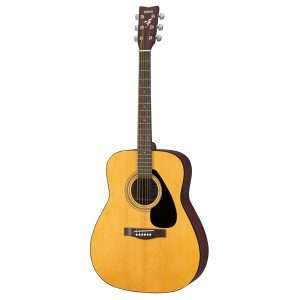 Yamaha F310 | 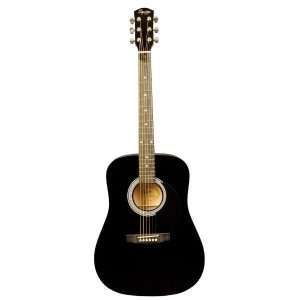 FENDER SQUIER SA-105 |
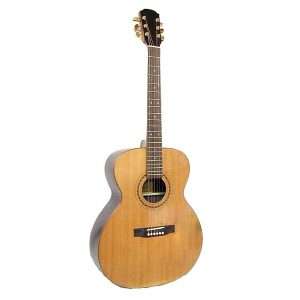 Strunal J977 | 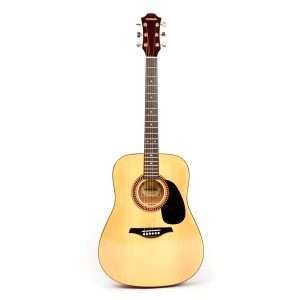 Hohner HW-220 |
 Parkwood P810 | 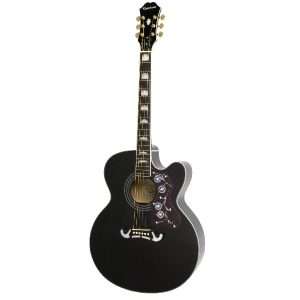 EPIPHONE EJ-200CE |
Overview of major guitar manufacturers
Strunal
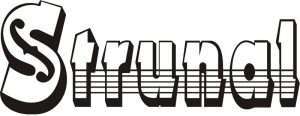
Czech music workshops under the general name “Cremona” have been operating since 1946, there were more than two hundred and fifty of them in total. The first instruments produced under the Cremona brand were violins (from the eighteenth century). Acoustic guitars were added already in the twentieth century.
In the Soviet Union, the Kremona brand guitar has always been considered a high quality instrument. It was strikingly different from the instruments produced, for example, at the Leningrad Musical Instruments Plant, but it was quite affordable. And now, after the reorganization of the factory, when the guitars are produced under the brand name “Strunal”, the name “Cremona” is associated with quality.
According to some professionals, the guitars of this factory are not inferior to the Spanish ones, but are more durable, since the climate of their homeland – the Czech Republic – is closer to the Russian climate than the Spanish one. The durability and strength even made it possible to install metal strings on classical guitars.
After the collapse of the USSR, the factory survived, the lineup was updated. Unfortunately, the well-known and recognizable name “Cremona” had to be abandoned, since this is the name of one of the provinces in Italy, famous for its violin makers. Now the factory is called “Strunal”.
The fastening of the neck and the guitars of this factory is made according to the so-called “Austrian” scheme, which gives the instrument additional strength. Due to structural differences, the sound of “Strunal” differs from the acoustics of classical Spanish guitars.
Now more than two dozen models of classical guitars “Strunal” are being produced, in addition, the factory produces acoustic guitars ” western ” and ” jumbo ” (about one and a half dozen models). Among the guitars “Strunal” you can find six-, nine- and twelve-string models. Strunal produces more than 50,000 acoustic guitars, 20,000 violins, 3,000 cellos and 2,000 double basses annually.
Gibson
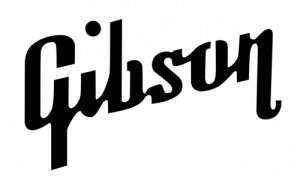
Gibson is an American manufacturer of musical instruments. Best known as a manufacturer of electric guitars.
Founded in 1902 by Orville Gibson, they were one of the first to manufacture solid-body guitars, which today are known simply as “electric guitars”. The principles of manufacturing solid-body guitars and pickups were brought to the company by the musician Les Paul (full name – Lester William Polfus), after whom one of the most popular series of guitars was subsequently named.
In the 60s – 70s of the twentieth century, it gained immense popularity due to the flourishing of rock music. Gibson Les Paul and Gibson SG guitars have become the main flagships of this company. Until now, they remain one of the best-selling electric guitars in the world.
Original Gibson Les Paul Standard electric guitars from the 1950s are now worth over a hundred thousand dollars and are sought after by collectors.
Some Gibson/Player Artists: Jimmy Page, Jimi Hendrix, Angus Young, Chet Atkins, Tony Iommi, Johnny Cash, BB King, Gary Moore, Kirk Hammett, Slash, Zack Wylde, Armstrong, Billy Joe, Malakian, Daron.
Hohner

The German company HOHNER has really existed since 1857. However, throughout its history, it has been known as a manufacturer of reed wind instruments – especially harmonicas.
In the late 90s, the Hohner HC-06 guitar seriously “reformatted” the music market in Russia, putting an end to the supply of low-quality unnamed guitars from China. It became simply pointless to import them: the HC-06 cost the same, and in terms of acoustics even the Czech Strunal propped up from below.
After the appearance of the HC-06 model, Russian masters specially dissected this guitar in order to understand why it plays so well. No secrets were found, just precisely selected (cheap) materials and a properly assembled case.
Almost all Hohner branded guitars are made in China. Technology and quality control are excellent. A defective Hohner is almost impossible to meet.
Martinez

Martinez is made in China under the order of our Russian partners. They are made in the same factory as the cheap Ibanez and Fender models, and using the same technologies. For example, the W-801 is an exact analogue of the Fender DG-3, the differences are only in the design nuances and the sticker. Martinez is cheaper because the buyer does not pay for the promoted brand.
The brand has existed for almost 10 years, the statistics have been extensive. The manufacturer maintains a very stable quality, there are few complaints. The bulk of the Martinez models are dreadnoughts , with excellent materials and finishes. The most budget models – W-701, 702, 801 – are typical Chinese guitars for elementary education. Older models are pleased with the quality and finish, especially the W-805. And all this lives well in our climate, which is important.
In general, Martinez is one of the most popular and relevant brands in the amateur class. It has been present on the Russian market for a long time and has established itself in a very worthy way.
Yamaha

A Japanese company that manufactures almost everything in the world. Since 1966, guitars have also been produced. There are no special innovations in these tools, but the quality of workmanship and the fundamental Japanese approach to product creation do their job.





